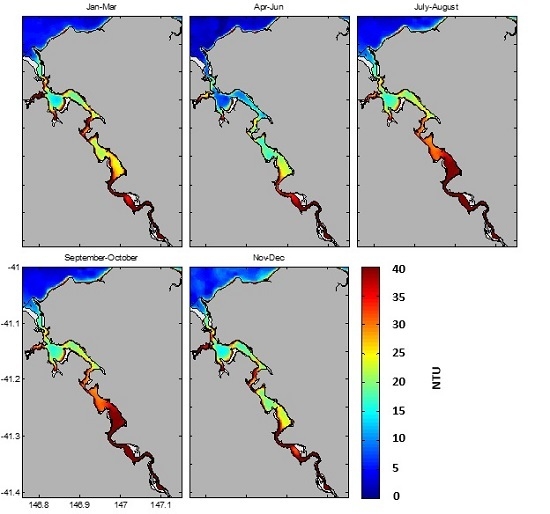Spatio-Temporal Variability in a Turbid and Dynamic Tidal Estuarine Environment (Tasmania, Australia): An Assessment of MODIS Band 1 Reflectance
Abstract
:1. Introduction
2. Study Area—Tamar River
3. Materials and Methods
3.1. In Situ Measurements and Analysis
3.2. MODIS Data and Processing
3.3. MODIS Reflectance Relationship to TSS, Turbidity and Secchi Depth
4. Results
4.1. Water Mass Characteristics
4.2. MODIS Reflectance vs. TSS and Turbidity
4.3. Correlation with Tides, Satellite crossing Time and Rainfall
4.4. Satellite-Derived Climatology
5. Discussion
6. Conclusions
Acknowledgments
Author Contributions
Conflicts of Interest
References
- Warren, J.A.; Berner, J.E.; Curtis, T. Climate change and human health: Infrastructure impacts to small remote communities in the north. Int. J. Circumpolar Health 2005, 64, 487–497. [Google Scholar] [CrossRef] [PubMed]
- Moreno-Madrinan, M.J.; Al-Hamdan, M.Z.; Rickman, D.L.; Muller-Karger, F.E. Using the Surface Reflectance MODIS Terra Product to Estimate Turbidity in Tampa Bay, Florida. Remote Sens. 2010, 2, 2713–2728. [Google Scholar] [CrossRef]
- Pratt, D.R.; Pilditch, C.A.; Lohrer, A.M.; Thrush, S.F. The effects of short-term increases in turbidity on sandflat microphytobenthic productivity and nutrient fluxes. J. Sea Res. 2014, 92, 170–177. [Google Scholar] [CrossRef]
- Johansen, J.L.; Jones, G.P. Sediment-induced turbidity impairs foraging performance and prey choice of planktivorous coral reef fishes. Ecol. Appl. 2013, 23, 1504–1517. [Google Scholar] [CrossRef] [PubMed]
- Hasenbein, M.; Komoroske, L.M.; Connon, R.E.; Geist, J.; Fangue, N.A. Turbidity and salinity affect feeding performance and physiological stress in the endangered delta smelt. Integr. Comp. Biol. 2013, 53, 620–634. [Google Scholar] [CrossRef] [PubMed]
- Xu, H.; Wolanski, E.; Chen, Z. Suspended particulate matter affects the nutrient budget of turbid estuaries: Modification of the LOICZ model and application to the Yangtze Estuary. Estuar. Coast. Shelf Sci. 2013, 127, 59–62. [Google Scholar] [CrossRef]
- Matveev, V.F.; Steven, A.D.L. The effects of salinity, turbidity and flow on fish biomass estimated acoustically in two tidal rivers. Mar. Freshw. Res. 2013. [Google Scholar] [CrossRef]
- Tal, A. Seeking sustainability: Israel’s evolving water management strategy. Science 2006, 313, 1081–1084. [Google Scholar] [CrossRef] [PubMed]
- Tegtmeier, E.M.; Duffy, M.D. External costs of agricultural production in the United States. Int. J. Agric. Sustain. 2004, 2, 1–20. [Google Scholar] [CrossRef]
- Juntunen, P.; Liukkonen, M.; Lehtola, M.J.; Hiltunen, Y. Dynamic soft sensors for detecting factors affecting turbidity in drinking water. J. Hydroinform. 2013, 15, 416–426. [Google Scholar] [CrossRef]
- Davis, J.; Kidd, I.M. Identifying Major Stressors: The Essential Precursor to Restoring Cultural Ecosystem Services in a Degraded Estuary. Estuar. Coast. 2012, 35, 1007–1017. [Google Scholar] [CrossRef]
- Kidd, I.M.; Chai, S.; Fischer, A. Tidal Heights in Hyper-Synchronous Estuaries. Nat. Resour. 2014, 5, 607–615. [Google Scholar] [CrossRef]
- Newcombe, C.P.; MacDonald, D.D. Effects of suspended sediments on aquatic ecosystems. N. Am. J. Fish. Manag. 1991, 11, 72–82. [Google Scholar] [CrossRef]
- Chutter, F.M. The effects of silt and sand on the invertebrate fauna of streams and rivers. Hydrobiologia 1969, 34, 57–76. [Google Scholar] [CrossRef]
- Wilber, D.H.; Clarke, D.G. Biological effects of suspended sediments: A review of suspended sediment impacts on fish and shellfish with relation to dredging activities in estuaries. N. Am. J. Fish. Manag. 2001, 21, 855–875. [Google Scholar] [CrossRef]
- Tamar Estuary and Esk Rivers (TEER) Program. Tamar Estuary 2016 Report Card, Ecosystem Health Assessment Program: Monitoring Period December 2014–November 2015; NRM North: Launceston, Australia, 2017. [Google Scholar]
- Miller, R.L.; Liu, C.C.; Buonassissi, C.J.; Wu, A.M. A multi-sensor approach to examining the distribution of total suspended matter (TSM) in the Albemarle-Pamlico estuarine system, NC, USA. Remote Sens. 2011, 3, 962–974. [Google Scholar] [CrossRef]
- Binding, C.E.; Bowers, D.G.; Mitchelson-Jacob, E.G. Estimating suspended sediment concentrations from ocean colour measurements in moderately turbid waters; the impact of variable particle scattering properties. Remote sens. Environ. 2005, 94, 373–383. [Google Scholar] [CrossRef]
- Manning, A.J.; Bass, S.J. Variability in cohesive sediment settling fluxes: Observations under different estuarine tidal conditions. Mar. Geol. 2006, 235, 177–192. [Google Scholar] [CrossRef]
- Freitas, P.T.; Asp, N.E.; e Souza-Filho, P.W.M.; Nittrouer, C.A.; Ogston, A.S.; da Silva, M.S. Tidal influence on the hydrodynamics and sediment entrapment in a major Amazon River tributary–Lower Tapajós River. J. S. Am. Earth Sci. 2017, 79, 189–201. [Google Scholar] [CrossRef]
- Joshi, I.D.; D’Sa, E.J.; Osburn, C.L.; Bianchi, T.S. Turbidity in Apalachicola Bay, Florida from Landsat 5 TM and Field Data: Seasonal Patterns and Response to Extreme Events. Remote Sens. 2017, 9, 367. [Google Scholar] [CrossRef]
- Constantin, S.; Constantinescu, Ș.; Doxaran, D. Long-term analysis of turbidity patterns in Danube Delta coastal area based on MODIS satellite data. J. Mar. Syst. 2017, 170, 10–21. [Google Scholar] [CrossRef]
- Amin, A.R.M.; Abdullah, K.; Lim, H.S.; Embong, M.F.; Ahmad, F.; Yaacob, R. Development of Regional TSS Algorithm over Penang using Modis Terra (250 M) Surface Reflectance Product. Ekológia (Bratislava) 2016, 35, 289–294. [Google Scholar] [CrossRef]
- Chen, Z.; Hu, C.; Muller-Karger, F. Monitoring turbidity in Tampa Bay using MODIS/Aqua 250-m imagery. Remote Sens. Environ. 2007, 109, 207–220. [Google Scholar] [CrossRef]
- Doxaran, D.; Froidefond, J.M.; Castaing, P.; Babin, M. Dynamics of the turbidity maximum zone in a macrotidal estuary (the Gironde, France): Observations from field and MODIS satellite data. Estuar. Coast. Shelf Sci. 2009, 81, 321–332. [Google Scholar] [CrossRef]
- Moreno-Madriñán, M.J.; Rickman, D.L.; Ogashawara, I.; Irwin, D.E.; Ye, J.; Al-Hamdan, M.Z. Using remote sensing to monitor the influence of river discharge on watershed outlets and adjacent coral reefs: Magdalena River and Rosario Islands, Colombia. Int. J. Appl. Earth Obs. Geoinform. 2015, 38, 204–215. [Google Scholar] [CrossRef]
- Kumar, A.; Equeenuddin, S.M.; Mishra, D.R.; Acharya, B.C. Remote monitoring of sediment dynamics in a coastal lagoon: Long-term spatio-temporal variability of suspended sediment in Chilika. Estuar. Coast. Shelf Sci. 2016, 170, 155–172. [Google Scholar] [CrossRef]
- Sharples, C. Indicative Mapping of Tasmanian Coastal Vulnerability to Climate Change and Sea-Level Rise: Explanatory Report, 2nd ed.; Consultant Report to Department of Primary Industries and Water, Tasmania; Department of Primary Industries & Water Tasmania: Hobart, Australia, 2006.
- Ellison, J.C.; Sheehan, M.R. Past, Present and Futures of the Tamar Estuary, Tasmania. In Estuaries of Australia in 2050 and Beyond; Springer: Dordrecht, The Netherlands, 2014; pp. 69–89. [Google Scholar]
- Maynard, D.; Gaston, T. Beneath the Tamar: More that Silt; NRM North: Launceston, Australia, 2010. [Google Scholar]
- Smith, B.J. Tamar Estuary. In The Companion to Tasmanian History; Centre for Tasmanian Historical Studies, University of Tasmania: Hobart, Australia, 2006; Available online: http://www.utas.edu.au/library/companion_to_tasmanian_history/T/Tamar%20estuary.htm (accessed on 31 March 2013).
- Wood, W.F. Report on the Tamar Estuary Physical Study; Study number 2; Department of Environmental and Land Management, Northern Regional Office: Launceston, Australia, 1992. [Google Scholar]
- Gunawardana, D.; Locatelli, A. Tamar Estuary Management Plan; Northern Tasmanian Natural Resource Management Association Inc: Launceston, Australia, 2008. [Google Scholar]
- Armstrong, N.S. Holocene Sedimentation and Heavy-Metal Contamination in the Industrialised Tamar River Estuary. Honours Thesis, University of Wollongong, Wollongong, Australia, 2005. [Google Scholar]
- Kidd, I.M.; Davis, J.; Seward, M.; Fischer, A. Bathymetric rejuvenation strategies for a degraded estuary. Ocean Coast. Manag. 2017, 142, 98–110. [Google Scholar] [CrossRef]
- ETS Worldwide Ltd. Tracer Analysis of Sediment Redistribution of Tamar Estuary for Launceston Flood Authority; Australian Maritime College Search: Launceston, Australia, 2015. [Google Scholar]
- Australian Government Bureau of Meteorology. Available online: http://www.bom.gov.au (accessed on 7 June 2013).
- Tamar Estuary and Esk Rivers Ecosystem Health Assessment Program (TEER EHAP). Tamar Estuary Ecosystem Health Assessment Program Monitoring Report 2012; NRM North: Launceston, Australia, 2012.
- Hu, C.; Chen, Z.; Clayton, T.D.; Swarzenski, P.; Brock, J.C.; Muller-Karger, F.E. Assessment of estuarine water-quality indicators using MODIS medium-resolution bands. Remote Sens. Environ. 2004, 93, 423–441. [Google Scholar] [CrossRef]
- Moran, M.A. Distribution of terrestrially derived dissolved organic matter on the southeastern U.S. continental shelf. Limnol. Oceanogr. 1991, 36, 1134–1149. [Google Scholar] [CrossRef]
- Moran, M.A.; Hodson, R.H. Dissolved humic substances of vascular plant origin in a coastal marine environment. Limnol. Oceanogr. 1994, 39, 762–771. [Google Scholar] [CrossRef]
- Reverb ECHO, EOSDIS NASA’s Earth Observing Systems, Data Administration System. Available online: https://reverb.echo.nasa.gov/ (accessed on 10 February 2013).
- Land Processes Distributed Active Archive Center. Available online: https://lpdaac.usgs.gov/tools/modis_reprojection_tool (accessed on 12 March 2013).
- Petus, C.; Chust, G.; Gohin, F.; Doxaran, D.; Froidefond, J.M.; Sagarminaga, Y. Estimating turbidity and total suspended matter in the Adour River plume (South Bay of Biscay) using MODIS 250-m imagery. Cont. Shelf Res. 2010, 30, 379–392. [Google Scholar] [CrossRef]
- Wang, M.; Shi, W.; Tang, J. Water property monitoring and assessment for China’s inland Lake Taihu from MODIS-Aqua measurements. Remote Sens. Environ. 2011, 115, 841–854. [Google Scholar] [CrossRef]
- Wu, G.; Leeus, J.; Skidmore, A.K.; Prins, H.H.; Liu, Y. Concurrent monitoring of vessels and water turbidity enhances the strength of evidence in remotely sensed dredging impact assessment. Water Res. 2007, 41, 3271–3280. [Google Scholar] [CrossRef] [PubMed]
- Wu, M.; Zhang, W.; Wang, X.; Luo, D. Application of MODIS satellite data in monitoring water quality parameters of Chaohu Lake in China. Environ. Monit. Assess. 2009, 148, 255–264. [Google Scholar] [CrossRef] [PubMed]
- Ody, A.; Doxaran, D.; Vanhellemont, Q.; Nechad, B.; Novoa, S.; Many, G.; Bourrin, F.; Verney, R.; Pairaud, I.; Gentili, B. Potential of high spatial and temporal ocean color satellite data to study the dynamics of suspended particles in a micro-tidal river plume. Remote Sens. 2016, 8, 245. [Google Scholar] [CrossRef] [Green Version]
- Edgar, G.J.; Barrett, N.S.; Graddon, D.J.; Last, P.R. The conservation significance of estuaries: A classification of Tasmanian estuaries using ecological, physical and demographic attributes as a case study. Biol. Conserv. 2000, 92, 383–397. [Google Scholar] [CrossRef]
- Kleypas, J.A. Coral Reef Development under Naturally Turbid Conditions: Fringing Reefs near Broad Sound, Australia. Coral Reefs 1996, 15, 153–167. [Google Scholar] [CrossRef]
- Fennessy, M.J.; Dyer, K.R.; Huntley, D.A. Size and settling velocity distributions of flocs in the Tamar estuary during a tidal cycle. Neth. J. Aquat. Ecol. 1994, 28, 275–282. [Google Scholar] [CrossRef]
- Eisma, D.; Li, A. Changes in suspended-matter floc size during the tidal cycle in the Dollar Estuary. Neth. J. Sea Res. 1993, 31, 107–117. [Google Scholar] [CrossRef]
- Doxaran, D.; Froidefond, J.-M.; Castaing, P. Remote-sensing reflectance of turbid sediment-dominated water. Reduction of sediment type variations and changing illumination conditions effects by use of reflectance ratios. Appl. Opt. 2003, 42, 2623–2634. [Google Scholar] [CrossRef] [PubMed]
- Lahet, F.; Ouillon, S.; Forget, P. A Three-component model of ocean color and its application in the Ebro River mouth area. Remote Sens. Environ. 2000, 72, 181–190. [Google Scholar] [CrossRef]
- Goransson, G.; Larson, M.; Bendz, D. Variation in turbidity with precipitation and flow in a regulated river system—river Gota Alv, SW Sweden. Hydrol. Earth Syst. Sci. 2013, 17, 2529–2542. [Google Scholar] [CrossRef]
- Estes, M.G.; Al-Hamdan, M.; Thom, R.; Quattrochi, D.; Woodruff, D.; Judd, C.; Jean, E.; Watson, B.; Rodriguez, H.; Johnson, H. Watershed and hydrodynamic modeling for evaluating the impact of land use change on submerged aquatic vegetation and seagrasses in Mobile Bay. In Proceedings of the Oceans 2009 MTS/IEEE Conference, Biloxi, MS, USA, 26–29 October 2009. [Google Scholar]
- Moreno-Madriñán, M.J.; Al-Hamdan, M.Z.; Rickman, D.L.; Ye, J. Relationship Between Watershed Land-Cover/Land-Use Change and Water Turbidity Status of Tampa Bay Major Tributaries, Florida, USA. Water Air Soil Pollut. 2012, 223, 2093–2109. [Google Scholar] [CrossRef]
- Elsner, P.; Spencer, T.; Moeller, I.; Smith, G.M. Multitemporal Remote Sensing of Coastal Sediment Dynamics. In Environmental Remote Sensing and Systems Analysis; CRC Press: Boca Raton, FL, USA, 2012. [Google Scholar]
- Ryan, J.P.; Dierrsen, H.M.; Kudela, R.M.; Scholin, C.A.; Johnson, K.S.; Sullivan, J.M.; Fischer, A.M.; Enaney, P.R.; Chavez, F.P. Coastal ocean physics and red tides. Oceanography 2005, 18, 247–255. [Google Scholar] [CrossRef]
- Fischer, A.M.; Ryan, J.P.; Rienecker, E.V. Fine scale mapping of the structure and composition of the Elkhorn Slough (California, USA) tidal plume. Estuar. Coast. Shelf Sci. 2017, 184, 10–20. [Google Scholar] [CrossRef]
- Sterckx, S.; Knaeps, E.; Bollen, M.; Trouw, K.; Houthuys, R. Operational Remote Sensing Mapping of Estuarine Suspended Sediment Concentrations (ORMES). In Proceedings of the CEDA Dredging Days, Antwerp, Belgium, 1–3 November 2006. [Google Scholar]
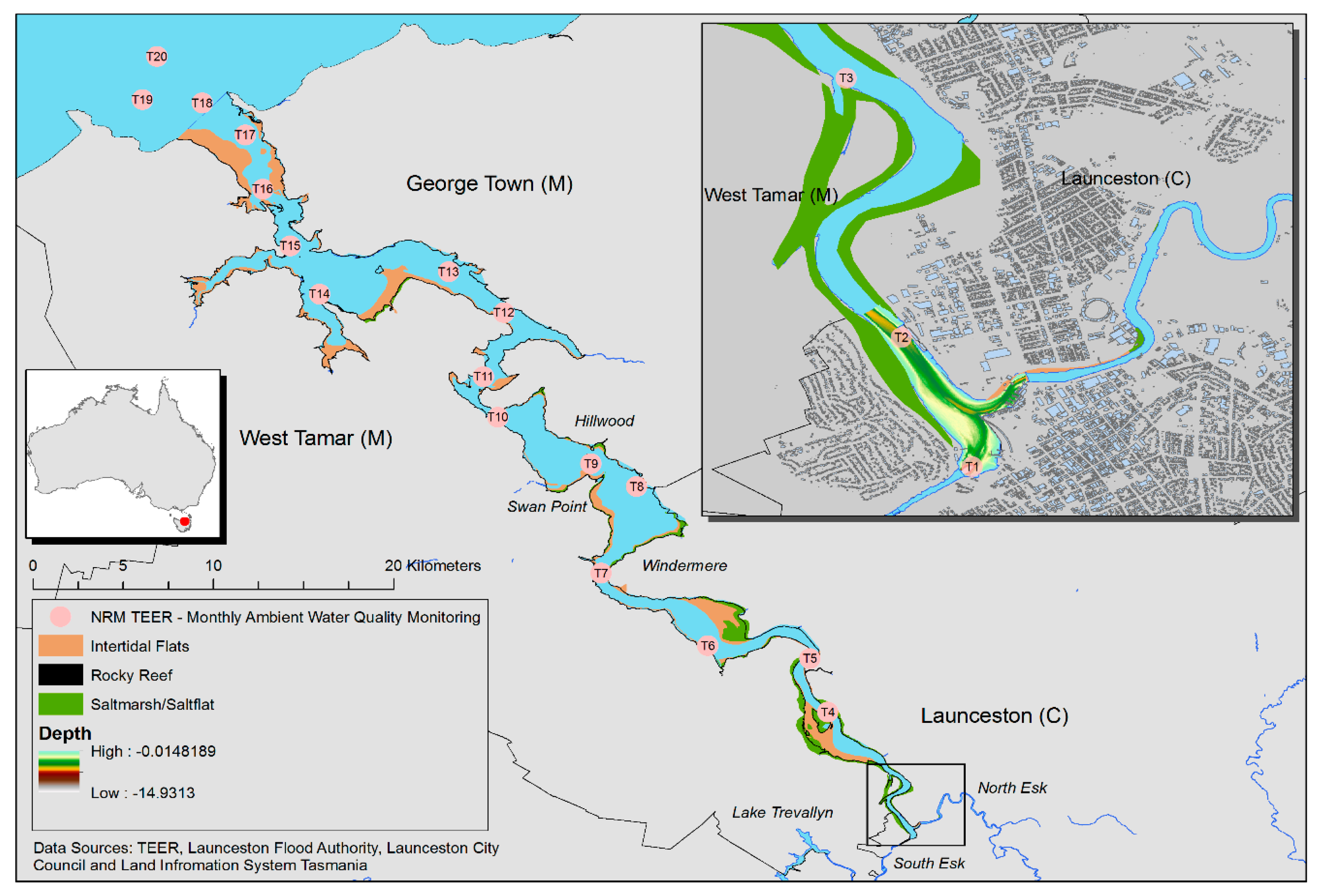
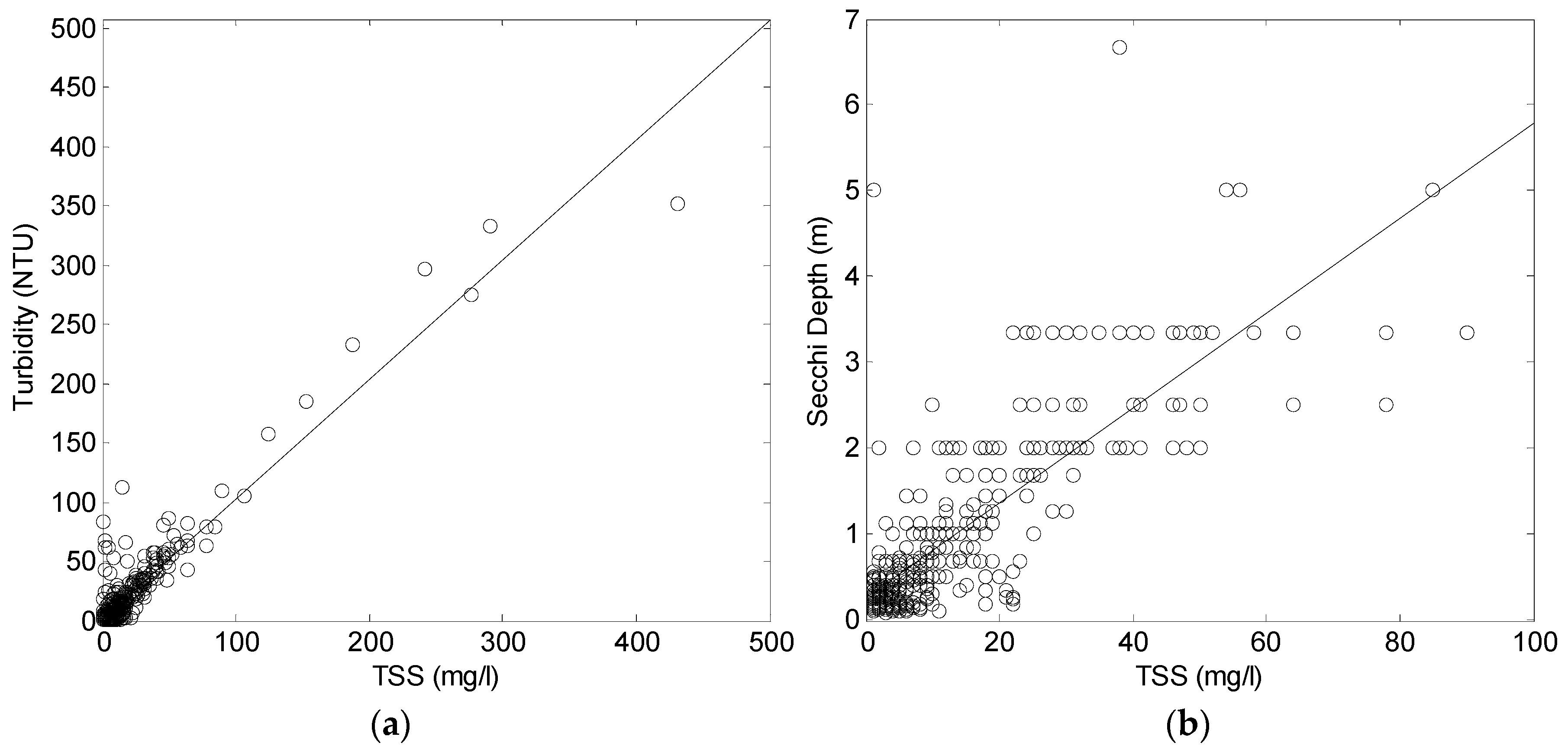


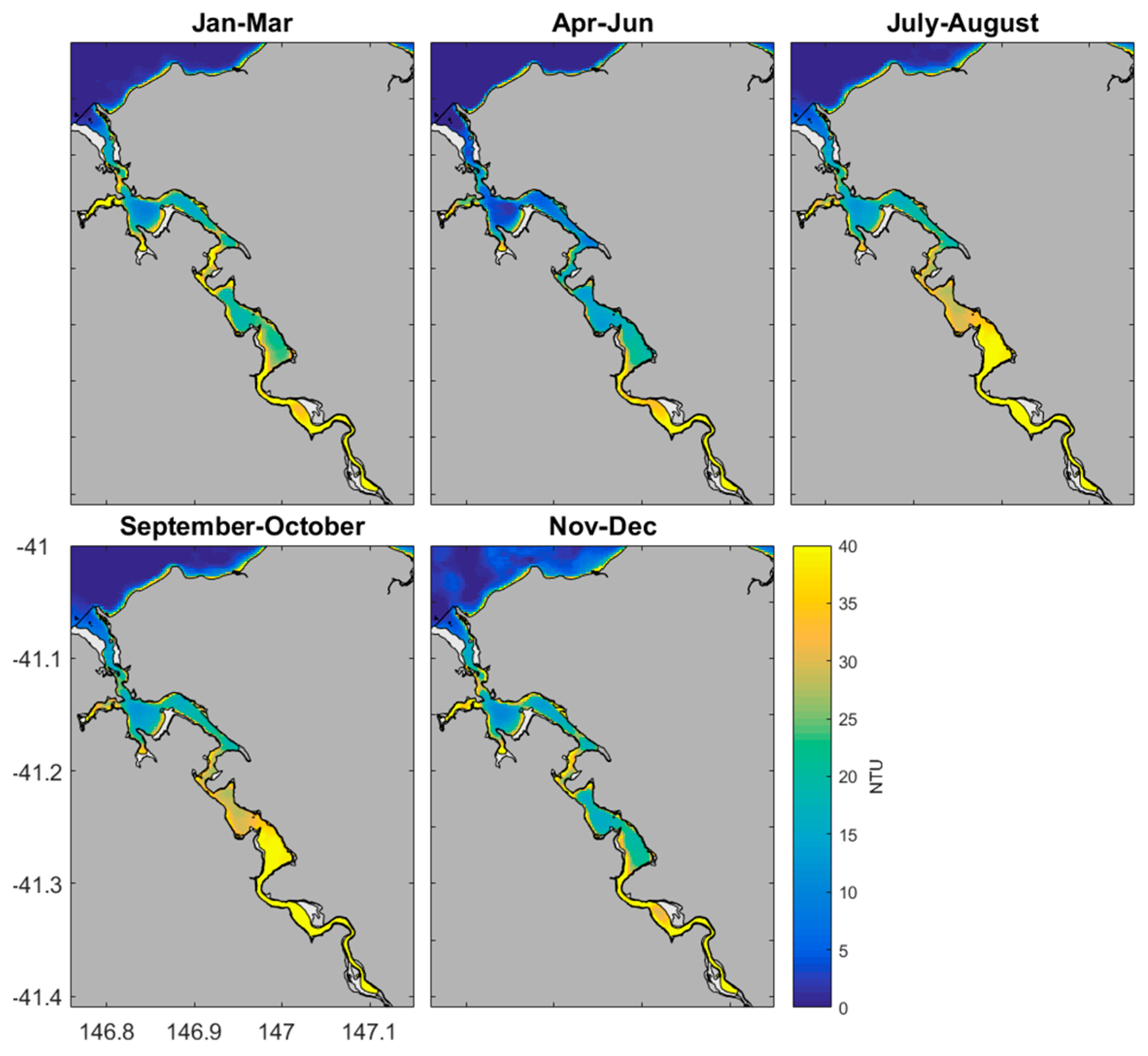
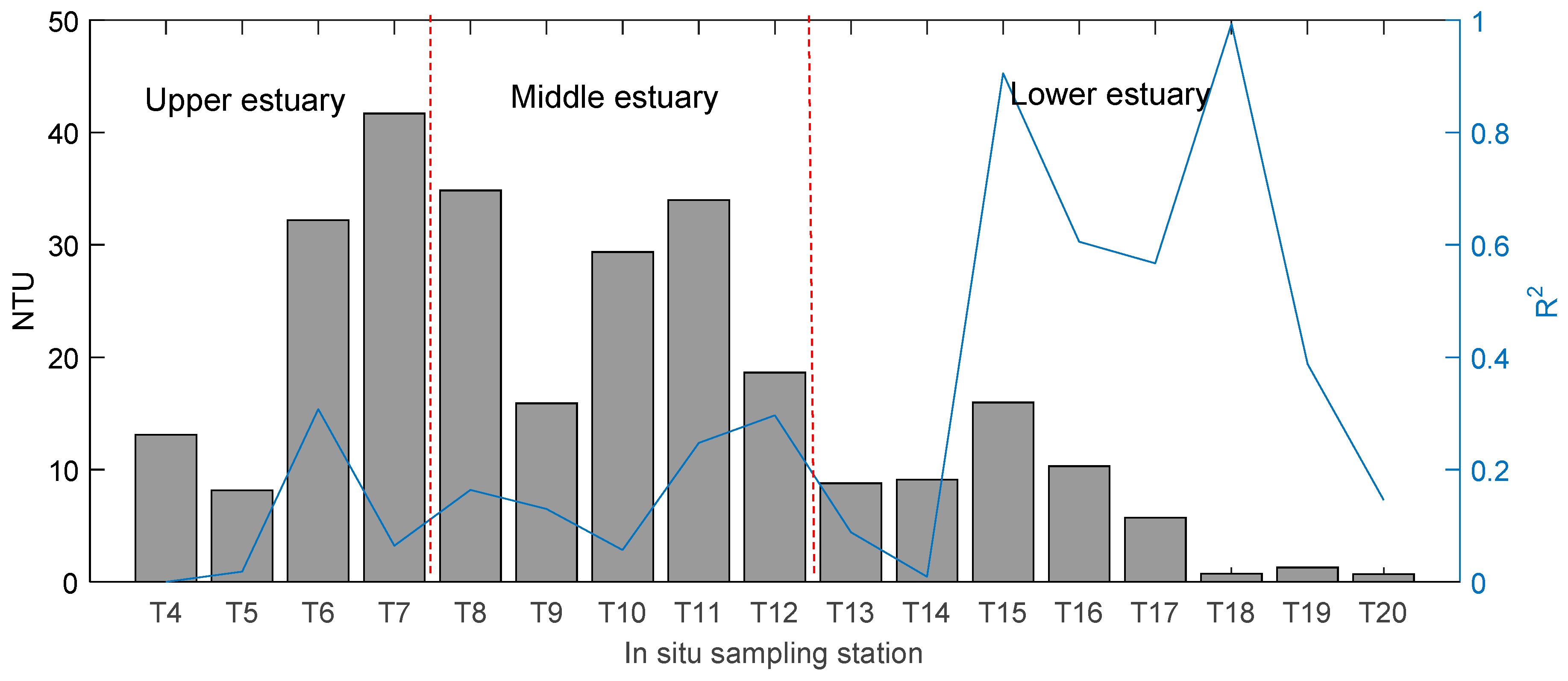
| Band Combination | r2 | N | p |
|---|---|---|---|
| TSS | |||
| Red | 0.168 | 112 | <0.01 |
| NIR | 0.056 | 102 | 0.02 |
| Red/NIR | 0.006 | 113 | 0.4 |
| NIR/Red | 0.005 | 104 | 0.5 |
| Secchi depth | |||
| Red | 0.282 | 111 | <0.01 |
| NIR | 0.125 | 101 | <0.01 |
| Red/NIR | 0.008 | 110 | 0.35 |
| NIR/Red | 0.018 | 101 | 0.18 |
| Turbidity | |||
| Red | 0.298 | 110 | <0.01 |
| NIR | 0.113 | 102 | <0.01 |
| Red/NIR | 0.004 | 111 | 0.47 |
| NIR/Red | 0.005 | 102 | 0.47 |
| Tide | r2 | N |
|---|---|---|
| All high tides | 0.478 | 50 |
| High tide (±6 h) | 0.477 | 49 |
| High tide (±5 h) | 0.275 | 47 |
| High tide (±4 h) | 0.305 | 43 |
| High tide (±3 h) | 0.372 | 37 |
| High tide (±2 h) | 0.324 | 25 |
| High tide (±1 h) | 0.546 | 14 |
| High tide (10:30 a.m.) | 0.987 | 4 |
| All low tides | 0.318 | 60 |
| Low tide (±4 h) | 0.309 | 59 |
| Low tide (±3 h) | 0.311 | 55 |
| Low tide (±2 h) | 0.379 | 41 |
| Low tide (±1 h) | 0.368 | 26 |
| Days after Rainfall | r2 | N | p |
|---|---|---|---|
| 0 | 0.43 | 42 | <0.01 |
| 1 | 0.60 | 34 | <0.01 |
| 2 | 0.34 | 21 | <0.01 |
| 3 | - | 1 | - |
| 5 | - | 2 | - |
| 7 | 0.01 | 7 | 0.83 |
| 10 | - | 2 | - |
© 2017 by the authors. Licensee MDPI, Basel, Switzerland. This article is an open access article distributed under the terms and conditions of the Creative Commons Attribution (CC BY) license (http://creativecommons.org/licenses/by/4.0/).
Share and Cite
Fischer, A.M.; Pang, D.; Kidd, I.M.; Moreno-Madriñán, M.J. Spatio-Temporal Variability in a Turbid and Dynamic Tidal Estuarine Environment (Tasmania, Australia): An Assessment of MODIS Band 1 Reflectance. ISPRS Int. J. Geo-Inf. 2017, 6, 320. https://doi.org/10.3390/ijgi6110320
Fischer AM, Pang D, Kidd IM, Moreno-Madriñán MJ. Spatio-Temporal Variability in a Turbid and Dynamic Tidal Estuarine Environment (Tasmania, Australia): An Assessment of MODIS Band 1 Reflectance. ISPRS International Journal of Geo-Information. 2017; 6(11):320. https://doi.org/10.3390/ijgi6110320
Chicago/Turabian StyleFischer, Andrew M., Daniel Pang, Ian M. Kidd, and Max J. Moreno-Madriñán. 2017. "Spatio-Temporal Variability in a Turbid and Dynamic Tidal Estuarine Environment (Tasmania, Australia): An Assessment of MODIS Band 1 Reflectance" ISPRS International Journal of Geo-Information 6, no. 11: 320. https://doi.org/10.3390/ijgi6110320




